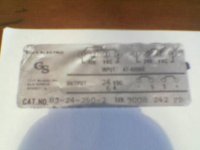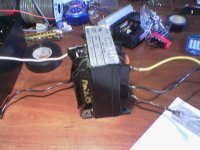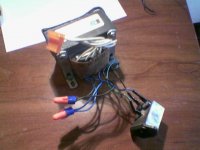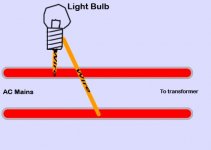I went to a recycling center - (my dad knows these guys who work there - the place is probably loaded with well-working transformers and capacitors  ) - and was digging through some stuff when I stumbled upon the most beautiful (maybe not visually but it was in GOOD condition) transformer. It's rated at 24v DC (huh? I'll Bridge Rectify it just in case
) - and was digging through some stuff when I stumbled upon the most beautiful (maybe not visually but it was in GOOD condition) transformer. It's rated at 24v DC (huh? I'll Bridge Rectify it just in case  ), 6a (YEEHAW!), and "47-420HZ" for hertz. Thats just it. Does that mean it can take 60HZ or does this mean something else? I really hope so! Thanks!
), 6a (YEEHAW!), and "47-420HZ" for hertz. Thats just it. Does that mean it can take 60HZ or does this mean something else? I really hope so! Thanks!
Hi,
if I am reading your pics correctly, you have a
290VA (6A *24*2) AC transformer.
That works from 47Hz to 400Hz. OK for 60Hz.
Has 2 120Vac primary windings that can be wired for 120Vac or 240Vac
Has two 24 Vac secondary windings that can be wired as centre tapped 24-0-24Vac, or separate 0-24, 0-24Vac, or paralleled 0-24Vac @ 12A.
Check for electrical isolation between all the separate windings and continuity through each winding.
When you first get ready to switch on, use a series light bulb to minimise (eliminate) the damage from a mis-wired connection.
If that VDC is not a typo then it's possible that the secondary voltage is only 17Vac and has been scaled to allow for rectification.
You are a brave (foolish?) man to consider plugging that mains connector into "live" supply on the IEC socket.
if I am reading your pics correctly, you have a
290VA (6A *24*2) AC transformer.
That works from 47Hz to 400Hz. OK for 60Hz.
Has 2 120Vac primary windings that can be wired for 120Vac or 240Vac
Has two 24 Vac secondary windings that can be wired as centre tapped 24-0-24Vac, or separate 0-24, 0-24Vac, or paralleled 0-24Vac @ 12A.
Check for electrical isolation between all the separate windings and continuity through each winding.
When you first get ready to switch on, use a series light bulb to minimise (eliminate) the damage from a mis-wired connection.
If that VDC is not a typo then it's possible that the secondary voltage is only 17Vac and has been scaled to allow for rectification.
You are a brave (foolish?) man to consider plugging that mains connector into "live" supply on the IEC socket.
The "BEEP"( which is really a short tester function ) for around 100 to 0 ohms measurer on my multimeter is what I used. I can go back and measure in actual precise ohms, if that means anything.
The secondaries were all "Beeping" as well.
I have a RadioShack digital multimeter with a good fuse. The "BEEEEEEP"
This could be because it is a big coil on the inside . I could always set up a test circuit with a fuse...hmm...not a bad idea
. I could always set up a test circuit with a fuse...hmm...not a bad idea 
The secondaries were all "Beeping" as well.
I have a RadioShack digital multimeter with a good fuse. The "BEEEEEEP"
This could be because it is a big coil on the inside

Hi,
the "beep" confirms continuity.
set your meter to lowest ohms scale (200r?)
measure each of the windings.
Those that are supposed to be the same should measure the same.
The primaries are likely to measure about 2r to 10r.
The secondaries will be less than 1r.
Did I say something about a light bulb four posts ago? DO IT!
the "beep" confirms continuity.
set your meter to lowest ohms scale (200r?)
measure each of the windings.
Those that are supposed to be the same should measure the same.
The primaries are likely to measure about 2r to 10r.
The secondaries will be less than 1r.
Did I say something about a light bulb four posts ago? DO IT!
Hi,
I have described the series mains light bulb a few times. Here's one http://www.diyaudio.com/forums/showthread.php?postid=927574#post927574
You can adjust it to suit different projects, low power bulb for low power projects, high power bulb etc.
Keep for every new mains powered project for first time start up and also when you carry out any maintenance. It can sometimes allow a failed project to start up for measuring & debugging.
It's main purpose is to stop you injuring yourself at switch on.
I have described the series mains light bulb a few times. Here's one http://www.diyaudio.com/forums/showthread.php?postid=927574#post927574
You can adjust it to suit different projects, low power bulb for low power projects, high power bulb etc.
Keep for every new mains powered project for first time start up and also when you carry out any maintenance. It can sometimes allow a failed project to start up for measuring & debugging.
It's main purpose is to stop you injuring yourself at switch on.
So if the light flashes and then dims, huh? 
Wouldn't it stay on full no matter what? The transformer would have enough current to let the lightbulb be on full all the time, like ac wiring anywhere would...right? I'll try this idea.
This is what you mean, right?

Wouldn't it stay on full no matter what? The transformer would have enough current to let the lightbulb be on full all the time, like ac wiring anywhere would...right? I'll try this idea.
This is what you mean, right?
Attachments
DJ Exprice said:So if the light flashes and then dims, huh?
Wouldn't it stay on full no matter what? The transformer would have enough current to let the lightbulb be on full all the time, like ac wiring anywhere would...right? I'll try this idea.
This is what you mean, right?
No, the light bulb should be in series with the transformer primary winding, you're showing a parallel connection. This is series:
Code:
L----------Bulb----------+
|
Transformer
Primary
|
N------------------------+The reasoning behind the series lightbulb trick is this. With no load your transformer will draw a little current, not enough to light the bulb so the circuit works as if the bulb isnt there.
If there was a fault in the transformer windings that caused it to draw a large current, the bulb would light brightly, which a) warns you something is wrong and b) limits the current to minimise damage.
As this is a transformer sourced from a junk pile, i'd strongly recommend you power it up this way!
24VDC rails is fine for a gainclone. This will give you about 30W into 8 ohms which is plenty for domestic listening.
If there was a fault in the transformer windings that caused it to draw a large current, the bulb would light brightly, which a) warns you something is wrong and b) limits the current to minimise damage.
As this is a transformer sourced from a junk pile, i'd strongly recommend you power it up this way!
24VDC rails is fine for a gainclone. This will give you about 30W into 8 ohms which is plenty for domestic listening.
- Status
- This old topic is closed. If you want to reopen this topic, contact a moderator using the "Report Post" button.
- Home
- Amplifiers
- Chip Amps
- Gainclone power supply transformer - Help!



